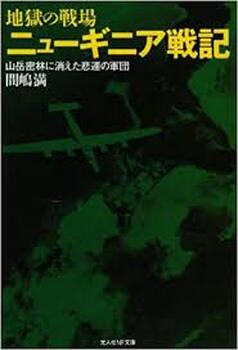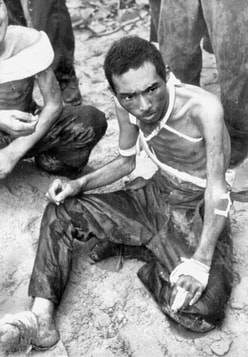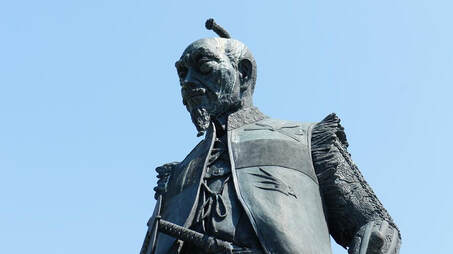 Majima Mitsuru, 'A War Diary of New Guinea', Source: amazon.co.jp
Majima Mitsuru, 'A War Diary of New Guinea', Source: amazon.co.jp Majima Mitsuru, “A War Diary of New Guinea: The ill-fated army that vanished among mountain peaks and jungles”, Kõjinsha, Reprinted 2003
Chapter One. Defence to the death, and self-sacrifice
An island of coral
Rabaul – an island whose exposure to the heat of the sun makes it seem as though it sits directly beneath the Equator; an island of coral surrounded by a crystal blue sea common to islands in the south and covered by jungle. It was an island that would be familiar to any Japanese who had heard the song titled “the air unit of Rabaul”. It is an island tempting enough to convince anybody to visit it at least once.
And yet it was a battlefield. There was no gaiety that you would find at any tourist resort. Beneath an unfamiliar sky, the entire base was surrounded by jungle. It was here that General Imamura Hitoshi, commander of the 8th Area Army, decided to place himself as the pivot for Japan’s southern strategy along with Lieutenant General Hyakutake Harukichi, commander of the Imperial Japanese Army’s 17th Army, who was subordinate to General Imamura. As for the Imperial Japanese Navy, Rabaul would serve as headquarters for Rear Admiral Kusaka Jinichi, commander of the Southeast Area Fleet, and under whose command fell the 8thFleet.
Rabaul was an important strategic point vital to the control of both the Solomon Islands and New Guinea itself. With its gentle waves, deep water and with an almost spherical, broad coastline, it formed a good, natural harbour. Small numbers of destroyers and submarines were able to weigh anchor there while awaiting their next mission. At first glance this arrangement looked peaceful and orderly, yet these vessels represented the remnants from various sea battles. The Battle of the Coral Sea in May of 1942, the Battle of Midway in June the same year, and then the First to Third Battles of the Solomon Islands that took place between August and November had resulted in the loss of IJN superiority to the allied fleet. These destroyers and submarines had evacuated to Rabaul with what was left of various units from Guadalcanal, and were mainly being used to ferry men and supplies to the front in New Guinea. (16-17)
At the entrance to the harbour lies a dormant volcano covered in grey volcanic ash. On the shoreline around the base of the volcano are shoals made of coral, from which steam escapes through fissures in the coral and form natural hot springs. As the island had no fresh water source of its own apart from rainwater, various units poured the hot spring water into cans and then used this for their baths. The flat plain from which steam rose up to cover the harbour was used as a base for air units. (17)
Along one section of the shoreline, the atmosphere was similar to that of small fishing villages that one could find in Japan. The unfinished houses that made up the village were made of flat, simple plywood, lined up one after another. A sober grocery store sold simple woven goods of earthen colours made by local people, or else metal goods. And everywhere one could see flowers that resembled weeds that grow virtually everywhere throughout the world, and which sprang back to life no matter how many times you stamped on them. (17) The company houses that the Caucasians had abandoned were used as lodgings for the command staff and naval officers. The army expeditionary units, out of their element on the sea, made do by dividing themselves up among the fields in the vicinity of the bay near the mountains or else on the red-capped peaks. (17-18) The narrow, flat plain areas located between the mountains were used to construct log cabins, with enough room in them for one company.
Nonetheless, it was a long trip from Hiroshima Bay (then known by its former name of Ujina Bay), which lasted around a month. Although cramped and smelly, when I think back of my time spent on those hot transport ships it seemed like heaven. The convoy that made its way south from Hiroshima would pass by way of Palau before finally arriving at Rabaul. The area just outside of Palau’s harbour had already become perilous to Japanese shipping. The convoy that set out at the start of 1943 and which managed to arrive safely at Rabaul was described as ‘lucky’, such was the danger of being sunk in the southern seas.
Once the convoy had made its way safely into Rabaul harbour, the harbour itself sprang back to life as the new units made landfall one after another. Black skinned natives, employed as dock workers in order to unload supplies, were crammed into army trucks in great numbers such was the amount of work for them to do. (18)
If you walked in front of the Kempeitai (security police) headquarters near the harbour, from the open windows you would hear the sound of angry voices within yelling “Are you a spy?” or “Are you trying to sabotage the military?”, accompanied by the sound of a whip landing with a ‘thwack’ on some black skin, followed in turn by an anguished scream. (18)
Sad news of the destruction of our combined fleet and the withdrawal from Guadalcanal soon reached us. In the midst of our consternation and loss of morale, we began to be ruled by fatalism. All of the news that made it to Rabaul spoke of defeat, with no room for any other news (other than that) concerning the worsening situation. After the failure of the attack on Port Moresby, we then learned of the sacrifice of the base at Buna, itself an important location. What it meant was that one corner of the defensive line in eastern New Guinea had collapsed. (18) While the military had declared that Rabaul alone would never be surrendered to the enemy, the general opinion was that given our isolation and lack of support, it was only a matter of time (before this happened). As a consequence, most of the labour was used to turn the entire island into a fortress, with a start made on creating a self-sufficient food supply. (19)
The first step towards destruction
The Solomon Islands is an archipelago running in a long line from north to south in the southern Pacific Ocean. It was also the scene of the last major battle for the Imperial Japanese Navy. Bougainville, the most important of islands in the chain, was maintained as the headquarters for the 17th Army and the 8th Fleet. However the losses at Midway and the Battles of the Solomon Islands, followed by the loss of Guadalcanal, completely changed the war’s dynamic in the South Pacific. (19)
Guadalcanal, a small island lying at the southern end of the archipelago, was virtually unknown to most Japanese who had no idea where it was located. Yet the defence of the South Pacific that began on this island, and which involved every military unit sent to the south, would become the first step in the disintegration of the Greater Japanese Empire. This scenario was something that neither the General Staff, nor their regional military subordinates, had ever even dreamed was possible. (19)
The successful extraction of the 13,000 troops of the 2nd Sendai Division (led by Lieutenant General Maruyama Masao) from Guadalcanal was regarded with pride as a triumph. And yet, the reality of the retreat and the failure of the reckless campaign could not be denied. The confusion and consternation of the central command and the regional armies was something equivalent to recklessness. The failure of the defence of Guadalcanal meant that every effort was put into the extraction plan, which ultimately succeeded. Yet what it also meant was that the shift to the defence of New Guinea would only be a matter of time. (20)
The decision to retreat from Guadalcanal ignored the threat to New Guinea posed by General Douglas MacArthur. It also spoke of the failure of the overly optimistic plan to transfer one section of the 17th Army to New Guinea once Guadalcanal was secured. It was a mistake to think that such a reactive strategy could proceed according to plan. (20)
The withdrawal from Guadalcanal meant those destroyers sent to extricate the troops ended up depositing them on the shores of Rabaul. Oh my, what a bunch of malnourished men they were, reduced to little more than skin and bones. These defeated, sick troops of the 2nd Division could not be sent to the front in New Guinea.
There existed a complacency in the belief of the Emperor’s army and its invincibility, and a distorted education system that taught that Japan was the ‘land of the gods’ and divinely blessed. This education, since it began in childhood, seeped its way into the very marrow of our being, starting with the military and then spreading throughout the nation.
There were, however, neither benevolent gods nor miracles present in the various battles of the South Pacific. (20)
We believed that a one-in-a-million chance fluke was the work of some divine presence. But there was no way that such events would or could continue. Worst case scenarios, in which a drowning man will clutch at straws and where prayers will go unanswered, showed the folly of such thinking. This came as a great shock to us all. It would in turn shatter the ambitions of the Japanese High Command and their southern fleet.
Yet for those of us born and raised in a militaristic country, there was no choice but to dutifully advance along the road to war.
Whatever the rights and wrongs of it were, once the war began, no matter how great your desire to win at all costs was or how ferocious your sense of duty to your country, the poor, antiquated capabilities of the Japanese military and civilian transport ships they relied on, which had been used since the time of the Sino-Japanese and Russo-Japanese wars, were no match for the modern weaponry, the speed of the landings, and the air transport capabilities of the US military. (21)
The High Command, by making light of the transport situation, effectively sent one part of their army into a starvation-ridden hell, which robbed soldiers of their vitality and fighting abilities and sent them headlong along the road to self-destruction.
One after another, the leaders of Japan taught the people to invoke the name of the Emperor as they went to a glorious death in battle, or else punish themselves by committing suicide to wipe away their shame, and impressed upon them their duty to fulfil these maxims. This was why to the Japanese mind, the evacuation of General MacArthur to Australia following his defeat at the Battle of Corregidor in The Philippines, abandoning his subordinates when he should have taken responsibility by committing ritual suicide, made him a figure for ridicule, and led to the sin of negligence to take hold of us out of our contempt for him. (22)
Yet no matter how many defeats or collapses occurred, the High Command, in their desire to preserve their honour, continued to report on the superiority of Japanese forces while those same forces were undergoing rapid disintegration. The transformation of the war situation led to desperation, which forced units on the frontline to participate in pointless campaigns, the end result of which was their death amid the hell of starvation. (22)
Meanwhile a certain nation, with its overwhelming economic power and manufacturing capability compared to Japan, was turning its automobile industries towards the mass production of aircraft. Air raids would soon be carried out against the Japanese mainland, with the Boeing B-29, the so-called “Superfortress”, the principal instrument for such attacks. It was said that in America, it was possible to turn out 50 such airplanes a day. The lack of research on the modern weapons manufacturing capabilities of the US was a huge error given the need to know one’s enemy. (22)
Speaking of the evils of the Japanese military, we were told that sending subordinates and commanders to their deaths (!) if the nation so demanded was in keeping with the traditional ethos of the warrior. We paid little heed to actual concepts of Bushidõ taught by social anthropologists or else ignored them completely.
The symbiosis of naked militarism with dogmatic thought laid the seeds for disaster. It was often said that “a samurai pretends he has eaten well when he has no food” (i.e., keeps a stiff upper lip), so even if we were forced to stoop to eating grass, we all believed that we would win in a stand-up fight. (22)
While mouthing platitudes about the need for minutely detailed preparations for campaigning, delays in sending incomplete supply runs to various battlefields became the norm. In China, one meaningless expression that got a lot of use was “local arrangements”. As those at the front line couldn’t halt their advance to receive food supplies, they requisitioned any cows, pigs or chickens that were close at hand. Hence anything that could be put to use for the sake of the campaign would be done so to the maximum extent possible. For the High Command, who put a lot of emphasis on this sort of thinking, their negligence in logistics would become the norm by the time of the Pacific War. (23)
In New Guinea, where there simply wasn’t enough material available to engage in “local arrangements”, fighting progressed from being one with weapons to the struggle to stave off the hell of starvation. (23)
By this time, Douglas MacArthur, the man the Japanese High Command regarded as utterly toothless, had arrived at Port Moresby with 3 full US divisions and had Boeing B-17 “Flying Fortress” heavy bombers at his disposal. The speed at which the Americans were able to deploy these forces completely transcended the expectations of the Japanese High Command. The first time we saw the bombers was in the sky over Rabaul. They passed over at night in the stratosphere. (23)
A number of gigantic shapes floated in the searchlights beaming from the various warships in the harbour. One after another they passed overhead, accompanied by a metallic whirring sound. Just the mere presence of these enormous shapes was enough to intimidate the Japanese forces on the ground. (23)
Speaking of MacArthur, he had been humiliated in The Philippines. For the sake of his honour, he had to recapture those islands. After his evacuation from Corregidor, he made his famous declaration “I shall return”. MacArthur, out of his sense of pride and destiny, and rather than brooding over his defeat, slowly but steadily built up the forces necessary for him to launch a counter-attack. It was a matter of course that he would have also included America’s overwhelming industrial and advanced military power in his calculations. By contrast, the Japanese High Command, when considering when the Americans might attack, believed that it would occur sometime after the summer of 1943. It was a miscalculation, an illusion born out of over-optimistic analysis of the results of the attack on Pearl Harbour. (24)
At the Battle of Midway, and then during the three battles for the Solomon Islands, the Imperial Japanese Navy had engaged in these conflicts with the full expectation that it would win. Yet what was the result?! Utter defeat, leading to the downfall of the IJN. An irreversible event. And it would serve as a catalyst for the misfortune and deprivation regarding the amount of supplies in eastern New Guinea, as well as their transport and distribution, that the New Guinea expeditionary force would be forced to suffer until the bitter end. (24)


 RSS Feed
RSS Feed